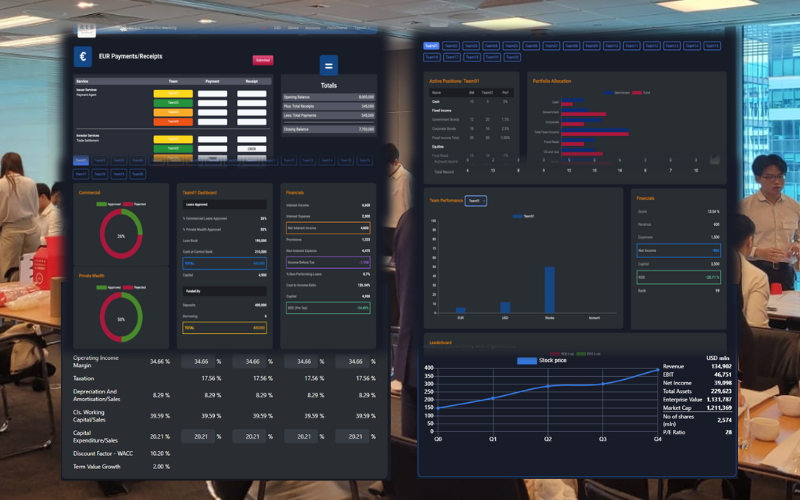How Virtual Simulations Are Transforming Onboarding for New Hires?
Introduction
In today’s fast-paced corporate world, the onboarding process for new hires is undergoing a significant transformation. Gone are the days of traditional, one-size-fits-all training programmes. Instead, companies are increasingly turning to virtual simulations to provide a more engaging, effective, and personalised onboarding experience.
The Rise of Virtual Simulations in Onboarding
What Are Virtual Simulations?
Virtual simulations are immersive, interactive training environments that mimic real-world scenarios. They utilise advanced technologies such as virtual reality (VR), augmented reality (AR), and sophisticated software to create lifelike situations where new hires can practise and hone their skills in a risk-free setting.
Why Are Companies Adopting Virtual Simulations?
- Engagement: Traditional training methods can be monotonous and fail to capture the attention of new hires. Virtual simulations, on the other hand, are interactive and engaging, making learning enjoyable and memorable.
- Retention: Studies show that people remember 90% of what they do, compared to just 10% of what they read and 20% of what they hear. By allowing new hires to ‘learn by doing’, virtual simulations significantly improve knowledge retention.
- Cost-Effective: While the initial investment in virtual simulation technology can be high, it often leads to long-term cost savings by reducing the need for physical training materials and in-person trainers.
- Scalability: Virtual simulations can be easily scaled to accommodate a growing workforce, making them ideal for companies experiencing rapid expansion.
Case Studies
Deloitte’s Virtual Office Tour
Deloitte, a leading global consultancy firm, has implemented a virtual office tour for new hires. Using VR headsets, new employees can explore the office, meet their colleagues, and familiarise themselves with the company’s culture before their first day. This innovative approach has led to higher levels of employee satisfaction and reduced first-day anxiety.
Walmart’s Virtual Reality Training
Walmart has integrated VR into its training programme to prepare employees for high-stress situations such as Black Friday. The simulation allows employees to experience the rush of customers and practise effective crowd management strategies. This hands-on training has improved employee confidence and performance during peak shopping periods.
The Benefits of Virtual Simulations
Virtual simulations are not just a technological novelty; they offer tangible benefits that significantly enhance the onboarding process for new hires. Here’s a detailed look at the key advantages:
Enhanced Learning Experience
Immersive and Interactive Training
Virtual simulations provide a hands-on learning experience that is both immersive and interactive. Unlike traditional training methods, which often involve passive learning through lectures or reading materials, virtual simulations engage new hires actively. They can practise real-life scenarios, receive instant feedback, and repeat exercises until they achieve mastery. This interactive approach leads to deeper understanding and better retention of information.
Real-World Scenarios
By simulating real-world scenarios, new hires can gain practical experience in a controlled environment. This helps them understand the complexities and challenges of their roles without the pressure of real-world consequences. For instance, a new customer service representative can practise handling difficult customers, or a new warehouse worker can learn the intricacies of inventory management.
Personalised Training
Customised Learning Paths
One of the standout features of virtual simulations is the ability to personalise training programmes. Companies can tailor simulations to individual learning styles and paces, ensuring that each new hire receives the support they need to succeed. This customised approach can address specific skill gaps and accelerate the learning process.
Adaptive Learning Technologies
Adaptive learning technologies, powered by artificial intelligence, can further enhance personalisation. These systems analyse a trainee’s performance in real-time and adjust the difficulty of tasks accordingly. This ensures that trainees are constantly challenged but not overwhelmed, leading to more effective learning outcomes.
Reduced Time to Competency
Accelerated Learning Curve
By providing new hires with practical experience from day one, virtual simulations help reduce the time it takes for them to become competent in their roles. This accelerated learning curve can lead to increased productivity and a faster return on investment. For example, a new hire in a technical role can practise complex procedures in a virtual environment and reach proficiency much quicker than through traditional training methods.
Immediate Application of Skills
Because virtual simulations mimic real-world tasks, new hires can immediately apply the skills they’ve learned to their actual job responsibilities. This seamless transition from training to real-world application enhances confidence and performance.
Safe Learning Environment
Risk-Free Practice
Virtual simulations offer a safe environment for new hires to make mistakes and learn from them without the fear of real-world consequences. This is particularly beneficial in high-risk industries such as healthcare or aviation, where mistakes can have serious repercussions. By allowing new hires to practise in a risk-free environment, companies can ensure that they are well-prepared for real-life challenges.
Encouraging Experimentation
A safe learning environment encourages experimentation and fosters a growth mindset. New hires can explore different approaches to tasks, test various solutions, and learn from their experiences. This not only enhances their problem-solving skills but also promotes innovation.
Cost-Effective Training
Long-Term Savings
While the initial investment in virtual simulation technology can be high, it often leads to long-term cost savings. Virtual simulations reduce the need for physical training materials, travel, and in-person trainers. Additionally, they can be reused and updated as needed, making them a cost-effective solution for ongoing training needs.
Scalability
Virtual simulations can be easily scaled to accommodate a growing workforce, making them ideal for companies experiencing rapid expansion. Once the initial simulation is developed, it can be deployed to new hires across different locations and time zones without additional costs.
Improved Engagement and Retention
Gamification Elements
Incorporating gamification elements such as points, badges, and leaderboards into virtual simulations can further enhance engagement and motivation. Gamified training programmes have been shown to improve participation and performance, making learning more enjoyable and rewarding.
Building a Learning Culture
By integrating virtual simulations into the onboarding process, companies can build a culture of continuous learning and development. This not only improves employee satisfaction and retention but also supports the overall growth and success of the organisation.
Current Trends and Innovations
As the adoption of virtual simulations in onboarding continues to grow, several key trends and innovations are shaping this dynamic field. These advancements are making virtual simulations more effective, accessible, and engaging than ever before. Here are some of the most notable trends and innovations in virtual simulations for onboarding new hires:
Gamification
Enhancing Engagement
Gamification involves incorporating game-like elements into training programmes, such as points, badges, leaderboards, and rewards. This approach makes learning more interactive and enjoyable, encouraging new hires to stay engaged and motivated. For example, employees might earn points for completing training modules or badges for mastering specific skills.
Competitive Spirit
Leaderboards can foster a healthy sense of competition among new hires, driving them to excel in their training. This competitive spirit can lead to higher levels of participation and performance, ultimately benefiting the organisation.
AI-Driven Simulations
Personalised Feedback
Artificial intelligence (AI) is increasingly being integrated into virtual simulations to provide personalised feedback and adaptive learning experiences. AI can analyse a trainee’s performance in real-time, identify areas for improvement, and offer tailored suggestions. This ensures that each new hire receives the support they need to succeed.
Dynamic Content
AI can also generate dynamic content that adjusts based on the trainee’s progress and proficiency. For instance, if a new hire excels in certain areas, the simulation can present more challenging scenarios to keep them engaged and continuously learning.
Remote Onboarding
Virtual Collaboration
With the rise of remote work, virtual simulations have become an essential tool for onboarding new hires who may never visit a physical office. These simulations can facilitate virtual collaboration, helping remote employees build connections with their colleagues and understand the company culture.
Accessible Training
Virtual simulations can be accessed from anywhere with an internet connection, making them ideal for remote onboarding. This accessibility ensures that all new hires, regardless of their location, receive a consistent and high-quality onboarding experience.
Augmented Reality (AR)
Enhanced Realism
Augmented reality (AR) overlays digital information onto the physical world, enhancing the realism of virtual simulations. AR can be used to provide real-time guidance and instructions during training exercises, helping new hires understand complex tasks and procedures.
Hands-On Training
For roles that require hands-on training, such as technical or mechanical positions, AR can provide a practical and immersive learning experience. New hires can interact with virtual objects and receive immediate feedback, improving their skills and confidence.
Virtual Reality (VR)
Immersive Experiences
Virtual reality (VR) offers fully immersive experiences that can transport new hires into realistic and engaging environments. This technology is particularly useful for training scenarios that are difficult to replicate in the real world, such as emergency response or high-stress situations.
Emotional Connection
VR can also create an emotional connection by simulating experiences that evoke empathy and understanding. For instance, diversity and inclusion training can use VR to help employees experience situations from different perspectives, fostering a more inclusive workplace culture.
Data Analytics
Measuring Effectiveness
Data analytics plays a crucial role in measuring the effectiveness of virtual simulations. By tracking key metrics such as completion rates, engagement levels, and performance scores, companies can gain valuable insights into the impact of their training programmes.
Continuous Improvement
Analytics can also identify trends and patterns that inform continuous improvement. For example, if data shows that certain simulation scenarios are consistently challenging for new hires, companies can adjust the content to provide additional support and resources.
Real-Time Collaboration Tools
Interactive Sessions
Real-time collaboration tools, such as virtual whiteboards and chat functions, can enhance the interactive nature of virtual simulations. These tools allow new hires to collaborate with trainers and peers in real-time, facilitating discussions and knowledge sharing.
Team-Based Simulations
Team-based simulations can foster teamwork and communication skills by requiring new hires to work together to solve problems and complete tasks. These collaborative exercises mirror real-world team dynamics, preparing employees for effective teamwork in their roles.
FAQs
How expensive is it to implement virtual simulations for onboarding?
The cost can vary depending on the complexity and scale of the simulation. However, many companies find that the long-term benefits and savings outweigh the initial investment.
Do virtual simulations replace traditional training methods entirely?
Not necessarily. Many companies use a blended approach, combining virtual simulations with traditional methods to provide a comprehensive training experience.
Can virtual simulations be customised for different industries?
Yes, virtual simulations can be tailored to suit the specific needs and challenges of different industries, from retail and hospitality to finance and healthcare.
What’s Next?
Virtual simulations are transforming the onboarding process by providing new hires with an engaging, effective, and personalised learning experience. As technology continues to advance, we can expect virtual simulations to become an even more integral part of corporate training programmes. Companies that embrace this innovative approach will be better positioned to attract, retain, and develop top talent in an increasingly competitive job market.
At MDA Training, we specialise in developing bespoke virtual simulation solutions tailored to your company’s unique needs. Our team of experts works closely with you to design immersive and interactive training programmes that enhance the onboarding experience for your new hires. By leveraging the latest technologies and industry best practices, we ensure that your training is not only engaging but also effective and aligned with your organisational goals.



















